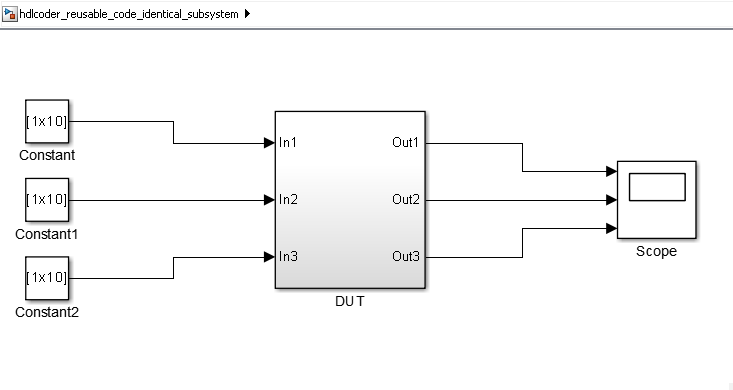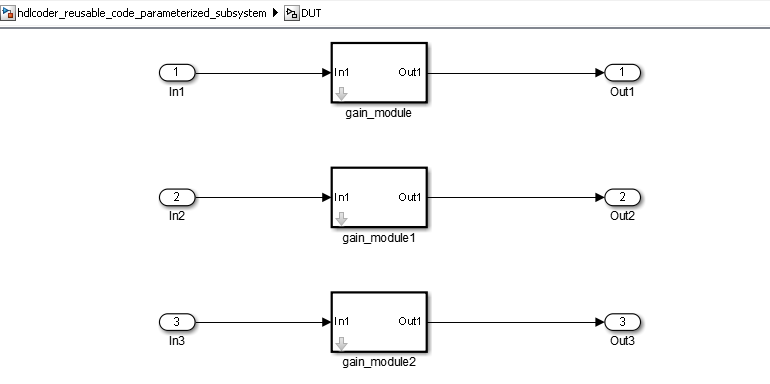Generate Reusable Code for Atomic Subsystems
HDL Coder™ can detect atomic subsystems that are identical, or identical except for their
mask parameter values, at any level of the model hierarchy, and
generate a single reusable HDL module or entity. The
reusable HDL code is generated as a single file and instantiated multiple times.
Requirements for Generating Reusable Code for Atomic Subsystems
To generate reusable HDL code for atomic subsystems:
The
DefaultParameterBehaviorSimulink® Configuration Parameter must beInlined. You can set this parameter at the command line by using theset_paramorhdlsetupfunction. To specify this setting in the Configuration Parameters dialog box, you must have Simulink Coder™.Note
Using
hdlsetupsets theInlineParamsproperty toon. Enabling this parameter is the same as settingDefaultParameterBehaviortoInlined. SettingInlineParamstooffchangesDefaultParameterBehaviorvalue toTunable.The atomic subsystems must be identical, or identical except for their mask parameter values.
MaskParameterAsGenericmust beon. For more information, see Generate parameterized HDL code from masked subsystem.Mask parameters must be nontunable. The code generator does not share atomic subsystems with mask parameters that are tunable.
Mask parameter data types cannot be
doubleorsingle.The tunable parameter must be used in only Constant or Gain blocks.
Port data types must match.
If you change the value of the tunable mask parameter, the output port data type can change. If one of the atomic subsystems has a different port data type, the code generated for that subsystem also differs.
Generate Reusable Code for Atomic Subsystems
If your design contains identical atomic subsystems, the coder generates one HDL
module or entity for the subsystem and instantiates
it multiple times.
Example
The hdlcoder_reusable_code_identical_subsystem model shows an
example of a DUT subsystem containing three identical atomic subsystems.


HDL Coder generates a single VHDL® file, vsum.vhd, for the three subsystems.
makehdl('hdlcoder_reusable_code_identical_subsystem/DUT')### Generating HDL for 'hdlcoder_reusable_code_identical_subsystem/DUT'.
### Starting HDL check.
### Generating new validation model: gm_hdlcoder_reusable_code_identical_subsystem_vnl.
### Validation model generation complete.
### Begin VHDL Code Generation for 'hdlcoder_reusable_code_identical_subsystem'.
### Working on hdlcoder_reusable_code_identical_subsystem/DUT/vsum/Sum of Elements as
hdl_prj\hdlsrc\hdlcoder_reusable_code_identical_subsystem\Sum_of_Elements.vhd.
### Working on hdlcoder_reusable_code_identical_subsystem/DUT/vsum as
hdl_prj\hdlsrc\hdlcoder_reusable_code_identical_subsystem\vsum.vhd.
### Working on hdlcoder_reusable_code_identical_subsystem/DUT as
hdl_prj\hdlsrc\hdlcoder_reusable_code_identical_subsystem\DUT.vhd.
### Generating package file hdl_prj\hdlsrc\hdlcoder_reusable_code_identical_subsystem\DUT_pkg.vhd.
### Creating HDL Code Generation Check Report DUT_report.html
### HDL check for 'hdlcoder_reusable_code_identical_subsystem' complete with 0 errors, 0 warnings, and 0 messages.
### HDL code generation complete.The generated code for the DUT subsystem, DUT.vhd, contains three
instantiations of the vsum component.
ARCHITECTURE rtl OF DUT IS
-- Component Declarations
COMPONENT vsum
PORT( In1 : IN vector_of_std_logic_vector16(0 TO 9); -- int16 [10]
Out1 : OUT std_logic_vector(19 DOWNTO 0) -- sfix20
);
END COMPONENT;
-- Component Configuration Statements
FOR ALL : vsum
USE ENTITY work.vsum(rtl);
-- Signals
SIGNAL vsum_out1 : std_logic_vector(19 DOWNTO 0); -- ufix20
SIGNAL vsum1_out1 : std_logic_vector(19 DOWNTO 0); -- ufix20
SIGNAL vsum2_out1 : std_logic_vector(19 DOWNTO 0); -- ufix20
BEGIN
u_vsum : vsum
PORT MAP( In1 => In1, -- int16 [10]
Out1 => vsum_out1 -- sfix20
);
u_vsum1 : vsum
PORT MAP( In1 => In2, -- int16 [10]
Out1 => vsum1_out1 -- sfix20
);
u_vsum2 : vsum
PORT MAP( In1 => In3, -- int16 [10]
Out1 => vsum2_out1 -- sfix20
);
Out1 <= vsum_out1;
Out2 <= vsum1_out1;
Out3 <= vsum2_out1;
END rtl;Generate Reusable Code for Atomic Subsystems with Tunable Mask Parameters
If your design contains atomic subsystems that are identical except for their tunable
mask parameter values, you can generate one HDL module or
entity for the subsystem. In the generated code, the
module or entity is instantiated multiple
times.
To generate reusable code for identical atomic subsystems, enable
MaskParameterAsGeneric for the model. By default,
MaskParameterAsGeneric is disabled.
For example, to enable the generation of reusable code for the atomic subsystems with
tunable parameters in the hdlcoder_reusable_code_parameterized_subsystem
model, enter:
hdlset_param('hdlcoder_reusable_code_parameterized_subsystem','MaskParameterAsGeneric','on')
Alternatively, in the Configuration Parameters dialog box, in the HDL Code Generation > Global Settings > Coding Style tab, enable the Generate parameterized HDL code from masked subsystem option.
Example
The hdlcoder_reusable_code_parameterized_subsystem model shows
an example of a DUT subsystem containing atomic subsystems that are identical except for
their tunable mask parameter values.


In hdlcoder_reusable_code_parameterized_subsystem/DUT, the gain
modules are subsystems with gain values represented by tunable mask parameters. Gain
values are: 4 for gain_module, 5 for gain_module1,
and 7 for gain_module2.
With MaskParameterAsGeneric enabled, HDL Coder generates a single source file, gain_module.v, for the
three gain module subsystems.
makehdl('hdlcoder_reusable_code_parameterized_subsystem/DUT','MaskParameterAsGeneric','on',... 'TargetLanguage','Verilog')
### Generating HDL for 'hdlcoder_reusable_code_parameterized_subsystem/DUT'.
### Starting HDL check.
### Begin Verilog Code Generation for 'hdlcoder_reusable_code_parameterized_subsystem'.
### Working on hdlcoder_reusable_code_parameterized_subsystem/DUT/gain_module as
hdlsrc\hdlcoder_reusable_code_parameterized_subsystem\gain_module.v.
### Working on hdlcoder_reusable_code_parameterized_subsystem/DUT as
hdlsrc\hdlcoder_reusable_code_parameterized_subsystem\DUT.v.
### Creating HDL Code Generation Check Report DUT_report.html
### HDL check for 'hdlcoder_reusable_code_parameterized_subsystem' complete with 0 errors, 0 warnings, and 0 messages.
### HDL code generation complete.The generated code for the DUT subsystem, DUT.v, contains three
instantiations of the gain_module component.
module DUT
(
In1,
In2,
In3,
Out1,
Out2,
Out3
);
input [7:0] In1; // uint8
input [7:0] In2; // uint8
input [7:0] In3; // uint8
output [31:0] Out1; // uint32
output [31:0] Out2; // uint32
output [31:0] Out3; // uint32
wire [31:0] gain_module_out1; // uint32
wire [31:0] gain_module1_out1; // uint32
wire [31:0] gain_module2_out1; // uint32
gain_module # (.myGain(4)
)
u_gain_module (.In1(In1), // uint8
.Out1(gain_module_out1) // uint32
);
assign Out1 = gain_module_out1;
gain_module # (.myGain(5)
)
u_gain_module1 (.In1(In2), // uint8
.Out1(gain_module1_out1) // uint32
);
assign Out2 = gain_module1_out1;
gain_module # (.myGain(7)
)
u_gain_module2 (.In1(In3), // uint8
.Out1(gain_module2_out1) // uint32
);
assign Out3 = gain_module2_out1;
endmodule // DUTIn gain_module.v, the myGain
Verilog®
parameter is generated for the tunable mask parameter.
module gain_module
(
In1,
Out1
);
input [7:0] In1; // uint8
output [31:0] Out1; // uint32
parameter [31:0] myGain = 4; // ufix32
wire [31:0] kconst; // ufix32
wire [39:0] Gain_mul_temp; // ufix40
wire [31:0] Gain_out1; // uint32
assign kconst = myGain;
assign Gain_mul_temp = kconst * In1;
assign Gain_out1 = Gain_mul_temp[31:0];
assign Out1 = Gain_out1;
endmodule // gain_module